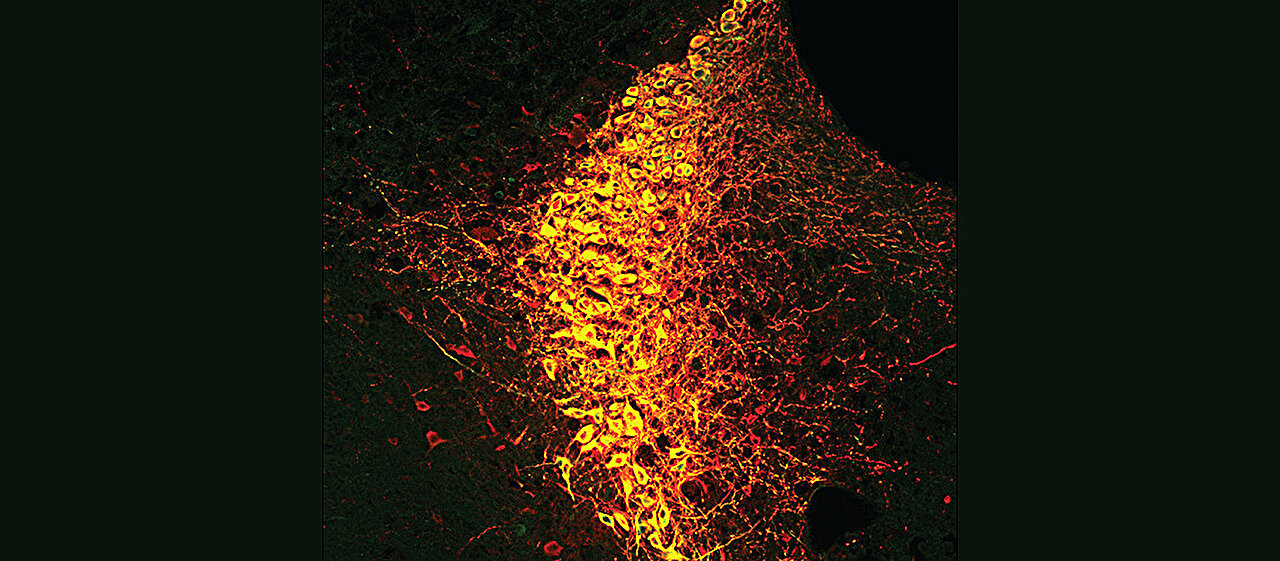Noradrenergic neurons in the locus coeruleus (LC) play a key role in the transition from a focused to an alert state. The image shows these neurons in the brain of mice, revealed by immunohistochemical staining. Credit: UNIGE/ETH Zurich
What allows the brain to go from intense concentration to a heightened state of alertness? A study conducted by neuroscientists at the University of Geneva (UNIGE), in collaboration with ETH Zurich, shows that a brain region called locus coeruleus (LC) and the neurotransmitter noradrenaline act as conductors and reorganize brain functions in accordance with the brain’s mental demands . moment.
The study, published in Nature Neuroscienceshows that the way the locus coeruleus is activated allows us to switch from one state of concentration to another. This discovery could change the way elite athletes train to achieve their goals.
How do athletes achieve the extraordinary mental clarity and precision needed to succeed in their discipline? The answer lies in the brain’s remarkable ability to focus, eliminating distractions to focus on a single task.
This phenomenon, often described as ‘being in the zone’, is a crucial skill not only for athletes, but for anyone faced with a challenging task, whether passing an exam or mastering a musical instrument. However, sometimes these people also need to be fully aware of their surroundings, especially when it comes to noticing potential dangers.
A handful of neurons
In this study, neuroscientists from UNIGE and ETH investigated what allows the brain to switch between intense focus and heightened awareness. The research team focused on the locus coeruleus (LC), a small area in the brain stem that produces norepinephrine, a neurotransmitter involved in regulating arousal.
‘It is small and its location deep in the brain has been challenging from the start, making it difficult to observe – and impossible to manipulate – in humans. For these reasons, we turned to mice where the LC consists of only about 3,000 neurons, but these neurons can still exert a significant influence on the 75 million neurons that make up the mouse brain,” explains Valerio Zerbi, assistant professor at the Department of Psychiatry and the Department of Basic Neuroscience of the UNIGE Faculty of Medicine, and initiator of the research. .
To tackle this challenge, his team collaborated with Johannes Bohacek’s laboratory at ETH Zurich. Using advanced techniques such as optogenetics to artificially manipulate LC neurons and photometry to measure norepinephrine release, the researchers were able to investigate LC function.
Functional Magnetic Resonance Imaging (fMRI) provided the first empirical evidence for how LC stimulation affects brain activity in different regions, shedding light on the role of LC in dynamically modulating attention and focus.
A matter of rhythm
Neuroscientists found that triggering the LC three times per second in a continuous manner – so-called ‘tonic’ activity – had different consequences than triggering the same frequency for a short period of time – so-called ‘burst’ activity.
“When the LC is activated in bursts, more norepinephrine is released and the brain’s sensory functions are prioritized. This sensory brain mode allows mice to be more alert to the environment around them,” Zerbi explains.
Conversely, when the LC is activated in a moderate tonic mode, less norepinephrine is released from the LC and brain areas such as the prefrontal cortex and hippocampus are activated. These two structures are known for processing information and are conducive to reflection and intense attention.
Control of the locus coeruleus for performance
“While sophisticated equipment and careful training are certainly part of the equation, perhaps the secret of elite athletes lies in their control of their LC. By fine-tuning its activity, they can switch between states of intense focus and broad awareness, allowing they can perform at their peak when it matters most,” concludes Zerbi.
Thanks to the findings of this study, brain imaging could help sportsmen and women better use their LC, especially by using neurofeedback approaches, a technique that uses devices to monitor brain activity in real time so that a person can regulate this. based on visual feedback.
More information:
Christina Grimm et al., Tonic and burst-like locus coeruleus stimulation clearly shift network activity across the cortical hierarchy, Nature Neuroscience (2024). DOI: 10.1038/s41593-024-01755-8. www.nature.com/articles/s41593-024-01755-8
Quote: The brain’s attention state is formed by a handful of neurons, according to research (2024, September 16) retrieved on September 16, 2024 from https://medicalxpress.com/news/2024-09-brain-state-attention-neurons. html
This document is copyrighted. Except for fair dealing purposes for the purpose of private study or research, no part may be reproduced without written permission. The content is provided for informational purposes only.





















